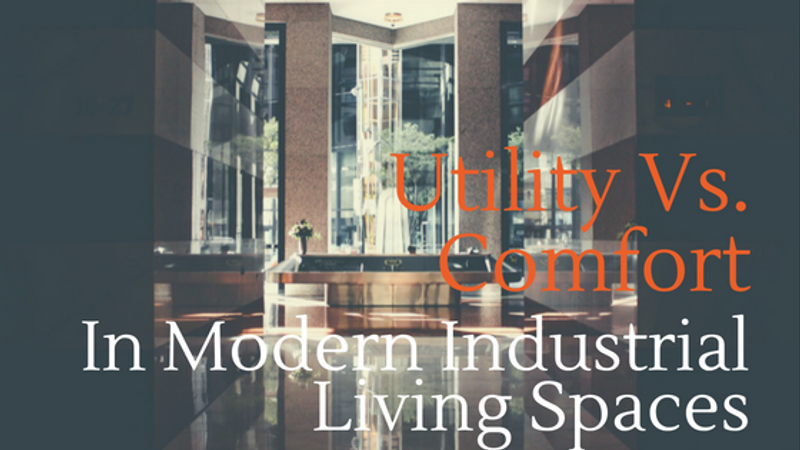
The re-investigation of industrial infrastructure as living space has sparked an intriguing and beautiful new architectural aesthetic the world over. The effect of building a home out of the forgotten spaces left behind by old industry has brought new meaning to the terms sustainable, up-cycled and re-imagined.
What these spaces offer to prospective buyers, is an in-depth look at how utilitarian spaces can be brought to life through exploring contrasting designs, textures, colours and emotions. In furnishing and decorating a space like this, there are no rules - but ending up with a space that flows and feels like a home, rather than a contemporary showpiece is the trick; the key is balancing comfort and utility.
Consider an industrial living space a blank canvas ready to accept just about anything you throw at it. In this post, we’ll break down the advantages and disadvantages of embracing this contrast, and how opposing forces of utility and comfort can co-exist peacefully.
Creating Warmth

Often times, these re-invented industrial spaces can feel cold, both as a result of their previous use, and through the means of their construction. Steel, brick, glass and concrete are all very cold materials, emotionally and physically. Their colours are often dingy, and they’re hard to the touch. Consider ramping up the implied warmth of the room by investing in some contrasting materials to add comfort.
In a huge open warehouse type space, consider experimenting with a 70’s inspired shag rug, or a persian alternative to draw attention away from the cold building materials. Paired with a warm hued wooden coffee table, plush sofa made from suede, velour, or a warm leather, and match postmodern end tables to help round out the look of the room.
Experiment with colour here as well - opting for red’s, oranges, and browns to help balance out the feeling of being surrounded by warmth. Shy away from blues and whites in furniture.
Or, try a simpler fix by swapping out existing light bulbs and replacing them with yellower, warmer bulbs, rather than the bright white bulbs. Even this change in visual lighting may help to breathe some life into cold materials that can feel overpowering in such dominating spaces.
Use the Height

In many of these modern industrial living spaces, you’ll be greeted by overwhelming height, meant to accommodate old equipment, lofts, offices and even storage in the building’s intended purpose. This is a designers dream - go with it.
Use the height of the roof to draw attention upwards, balancing the utilitarian aesthetic of your surroundings with an elegant chandelier or set of lights that drop down many feet from the ceiling to cover a dining room table, or living room helps to fill the abundance of open space, which may help to make the room feel cozier, more accommodating, and inviting.
Similarly, you can use this height to build a humanizing space like a library, gallery wall of photographs, or storage. In the kitchen, use the height of the space to incorporate an overhead hanging storage space for pots and pans.
Contrasting Textures
Wood is a great material to help balance dominant industrial materials. Consider installing a hardwood floor to bring both warmth and approachability to an industrial space. In many cases, old factory buildings and barns will feature an antique hardwood floor; these can be refinished, or polished to bring the imperfections out along with the warmth of the wood, accentuating the building’s past. This can be done by exposing posts and beams, or bringing in new wooden pieces.
Similarly, in spaces that feature lots of wood already, accent these rooms with contrasting stainless steel countertops, industrial storage solutions built from plumbing, concrete floors or counters, etc.
Adding balance in the reverse way can help to blend them space into something unique from its intended purpose. Even a drywalled accent wall painted white can bring a postmodern element to a rural space like a refurbished barn, or red brick factory.

Light
Allowing for lots of natural light in industrial spaces is a great way to help draw attention to the fact that people live there. Natural sunlight adds an element of life and humanization to the room.
If you’re lucky, your new abode will feature the typical floor to ceiling warehouse windows that are sought after features. These can be dressed up with long, flowing curtains that allow light to penetrate ever-so-slightly. By using a warm colour, the natural light that enters the room from these massive windows will have a warm tone, further helping to bring life to the room.
Consider dimming lights to help add drama to a postmodern industrial space as well.
Postmodern Touches
Helping an industrial home maintain its utilitarian ethos is a crucial part of exploring your new space. Remember: you’re not trying to hide the building’s past, nor are you trying to draw attention to it all the time. You’re trying to balance the history of the space, while showing off that it’s inhabited by people - who raise kids, entertain, and live there.
Adding eclectic and unique architectural touches to an industrial space help to keep the functional aspect of the factory-made mentality. Features like garage doors that lead to a patio or deck can add a distinctly utilitarian feel while maintaining the ability to translate light and use increased ceiling height into the revamped space. A vintage wood stove, stone mural, or galvanized steel wall accents can also fill this void.
Whatever your space dictates, the gist of balancing comfort with the utilitarian nature of these postmodern industrial homes is the balance of life and manufactory. This balance is what makes living in a space such as this a visually interesting and appealing alternative to a conventional home. Further, the upcycling nature of refurbishing an unusual space as home lends itself well to making use of the abandoned industrial sectors of many major cities across North America.

